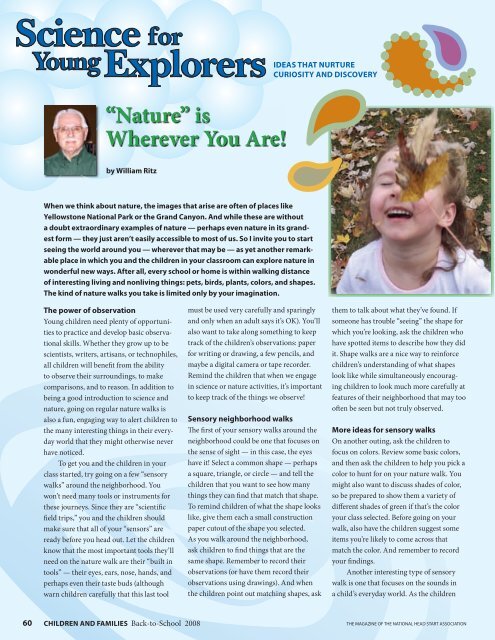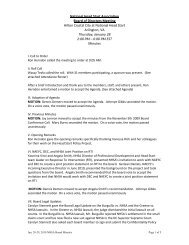New! - National Head Start Association
New! - National Head Start Association
New! - National Head Start Association
Create successful ePaper yourself
Turn your PDF publications into a flip-book with our unique Google optimized e-Paper software.
Science for<br />
Young Explorers<br />
“Nature” is<br />
Wherever You Are!<br />
by William Ritz<br />
When we think about nature, the images that arise are often of places like<br />
Yellowstone <strong>National</strong> Park or the Grand Canyon. And while these are without<br />
a doubt extraordinary examples of nature — perhaps even nature in its grandest<br />
form — they just aren’t easily accessible to most of us. So I invite you to start<br />
seeing the world around you — wherever that may be — as yet another remarkable<br />
place in which you and the children in your classroom can explore nature in<br />
wonderful new ways. After all, every school or home is within walking distance<br />
of interesting living and nonliving things: pets, birds, plants, colors, and shapes.<br />
The kind of nature walks you take is limited only by your imagination.<br />
The power of observation<br />
Young children need plenty of opportunities<br />
to practice and develop basic observational<br />
skills. Whether they grow up to be<br />
scientists, writers, artisans, or technophiles,<br />
all children will bene t from the ability<br />
to observe their surroundings, to make<br />
comparisons, and to reason. In addition to<br />
being a good introduction to science and<br />
nature, going on regular nature walks is<br />
also a fun, engaging way to alert children to<br />
the many interesting things in their everyday<br />
world that they might otherwise never<br />
have noticed.<br />
To get you and the children in your<br />
class started, try going on a few “sensory<br />
walks” around the neighborhood. You<br />
won’t need many tools or instruments for<br />
these journeys. Since they are “scienti c<br />
eld trips,” you and the children should<br />
make sure that all of your “sensors” are<br />
ready before you head out. Let the children<br />
know that the most important tools they’ll<br />
need on the nature walk are their “built in<br />
tools” — their eyes, ears, nose, hands, and<br />
perhaps even their taste buds (although<br />
warn children carefully that this last tool<br />
must be used very carefully and sparingly<br />
and only when an adult says it’s OK). You’ll<br />
also want to take along something to keep<br />
track of the children’s observations: paper<br />
for writing or drawing, a few pencils, and<br />
maybe a digital camera or tape recorder.<br />
Remind the children that when we engage<br />
in science or nature activities, it’s important<br />
to keep track of the things we observe!<br />
Sensory neighborhood walks<br />
e rst of your sensory walks around the<br />
neighborhood could be one that focuses on<br />
the sense of sight — in this case, the eyes<br />
have it! Select a common shape — perhaps<br />
a square, triangle, or circle — and tell the<br />
children that you want to see how many<br />
things they can nd that match that shape.<br />
To remind children of what the shape looks<br />
like, give them each a small construction<br />
paper cutout of the shape you selected.<br />
As you walk around the neighborhood,<br />
ask children to nd things that are the<br />
same shape. Remember to record their<br />
observations (or have them record their<br />
observations using drawings). And when<br />
the children point out matching shapes, ask<br />
IDEAS THAT NURTURE<br />
CURIOSITY AND DISCOVERY<br />
them to talk about what they’ve found. If<br />
someone has trouble “seeing” the shape for<br />
which you’re looking, ask the children who<br />
have spotted items to describe how they did<br />
it. Shape walks are a nice way to reinforce<br />
children’s understanding of what shapes<br />
look like while simultaneously encouraging<br />
children to look much more carefully at<br />
features of their neighborhood that may too<br />
o en be seen but not truly observed.<br />
More ideas for sensory walks<br />
On another outing, ask the children to<br />
focus on colors. Review some basic colors,<br />
and then ask the children to help you pick a<br />
color to hunt for on your nature walk. You<br />
might also want to discuss shades of color,<br />
so be prepared to show them a variety of<br />
di erent shades of green if that’s the color<br />
your class selected. Before going on your<br />
walk, also have the children suggest some<br />
items you’re likely to come across that<br />
match the color. And remember to record<br />
your ndings.<br />
Another interesting type of sensory<br />
walk is one that focuses on the sounds in<br />
a child’s everyday world. As the children<br />
60 CHILDREN AND FAMILIES Back-to-School 2008<br />
THE MAGAZINE OF THE NATIONAL HEAD START ASSOCIATION




